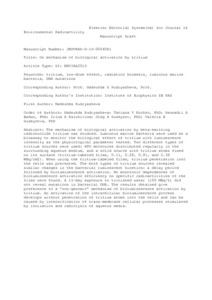On mechanism of biological activation by tritium
Скачать файл:
URI (для ссылок/цитирований):
https://elib.sfu-kras.ru/handle/2311/27993Автор:
Рожко, Т. В.
Бадун, Г. А.
Разживина, И. А.
Гусейнов, О. А.
Гусейнова, В. Е.
Кудряшева, Н. С.
Коллективный автор:
Научно-исследовательская часть
Дата:
2016-03Журнал:
Journal of Environmental RadioactivityКвартиль журнала в Scopus:
Q1Квартиль журнала в Web of Science:
Q2Библиографическое описание:
Рожко, Т. В. On mechanism of biological activation by tritium [Текст] / Т. В. Рожко, Г. А. Бадун, И. А. Разживина, О. А. Гусейнов, В. Е. Гусейнова, Н. С. Кудряшева // Journal of Environmental Radioactivity. — 2016. — Т. 157. — С. 131-135Аннотация:
The mechanism of biological activation by beta-emitting radionuclide tritium was studied. Luminous marine bacteria were used as a bioassay to monitor the biological effect of tritium with luminescence intensity as the physiological parameter tested. Two different types of tritium sources were used: HTO molecules distributed regularly in the surrounding aqueous medium, and a solid source with tritium atoms fixed on its surface (tritium-labeled films, 0.11, 0.28, 0.91, and 2.36 MBq/cm2). When using the tritium-labeled films, tritium penetration into the cells was prevented. The both types of tritium sources revealed similar changes in the bacterial luminescence kinetics: a delay period followed by bioluminescence activation. No monotonic dependences of bioluminescence activation efficiency on specific radioactivities of the films were found. A 15-day exposure to tritiated water (100 MBq/L) did not reveal mutations in bacterial DNA. The results obtained give preference to a “non-genomic” mechanism of bioluminescence activation by tritium. An activation of the intracellular bioluminescence process develops without penetration of tritium atoms into the cells and can be caused by intensification of trans-membrane cellular processes stimulated by ionization and radiolysis of aqueous media.

